iPad Pro (2020) versus MacBook Air (2020): Performance & features
More than ever before, Apple's iPad Pro and MacBook Air are competitors as hardware and software advances. AppleInsider pits them against one another to highlight the biggest differences to see which is the better buy.
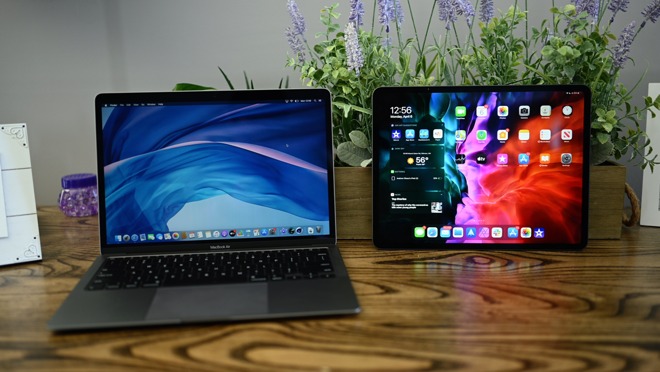
12.9-inch iPad Pro (right) and MacBook Air (left)
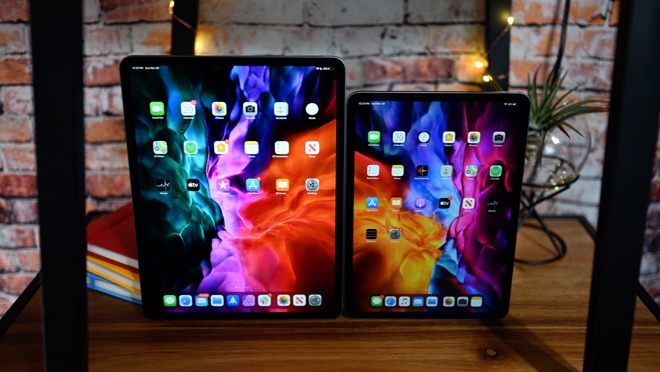
11 and 12.9-inch iPad Pros
Apple's iPad Pro has a single USB-C port, a gorgeous Liquid Retina display that comes in 11-inch and 12.9-inch sizes, a 7MP TrueDepth camera system, a 12MP wide-angle camera, a 10MP ultra-wide camera, a LiDAR scanner, and an incredible A12Z Bionic processor. See more of these in the full review.
The iPad is running the latest version of iPadOS, Apple's forked version of iOS designed for tablets which has truly transformed over the past few years. With the last few major updates, we got the ability to multitask, have picture-in-picture, run split-screen apps, use an external monitor, a real cursor, save to external storage, and more.
The MacBook Air has benefitted from added features in macOS too. As a more mature OS, there is less flair coming with each update. MacBook Air has been able to do almost everything that the iPad can do for many years.
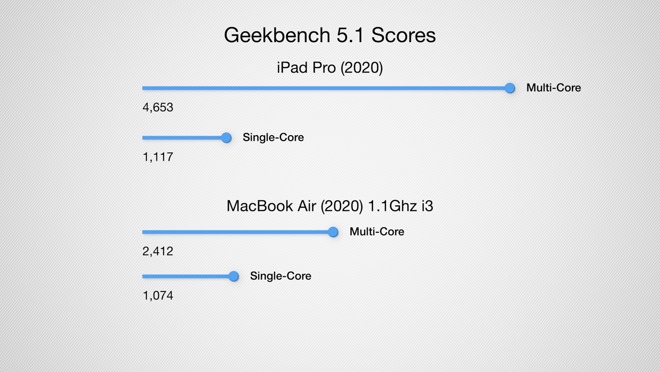
Geekbench 5.1 scores for iPad Pro and MacBook Air
When we run the latest Geekbench 5.1 benchmark on the pair, it is clear the iPad Pro is powerful. iPad Pro garnered a 1117 and a 4653 in the single-core and multi-core tests respectively. That compares to a 1074 and 2412 the i3 MacBook Air earned.
Even when you shell out the $250 additional to get the quad-core i7 processor, the iPad Pro still wins. The i7 MacBook Air improved, but only to a 1294 single-core and a 3514 multi-core.
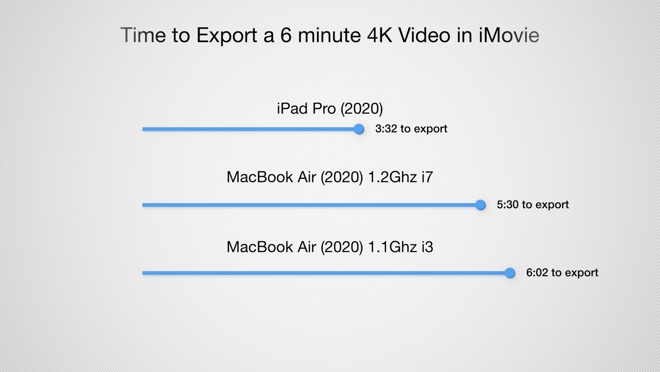
Video export test results
For a real-world test, we exported a 4K six-minute movie from iMovie on each device. The i3 MacBook Air took six minutes and two seconds, the i7 MacBook Air took five and a half minutes, and the iPad Pro only took three and a half minutes.
When it comes to processor-heavy or graphics-heavy tasks such as video editing, photo editing, iPad Pro is the better device to own, if you can handle doing so on iPadOS.
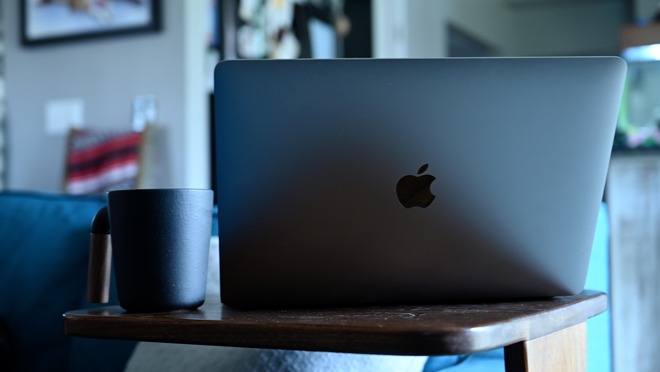
2020 MacBook Air
We'd have to outfit the 12.9-inch iPad Pro with the Magic Keyboard (let's keep things first-party instead of looking at cheaper third-party options). That brings your total to roughly $1,350 for a similar-sized screen with a trackpad, keyboard, and two USB-C ports.
On the MacBook Air side, we need to increase its performance to get closer to the iPad Pro powerhouse. That means opting for the quad-core i7 processor which runs $250 on top of the $999 entry-level i3.
That puts two machines about $100 of one another.
MacBook Air is stuck in its clamshell form factor, is slower than the iPad Pro even when you pay hundreds to upgrade the processor inside. There is no touch screen, no Apple Pencil support -- although though there are third-party sketchpads that can be used, no rear-shooting cameras at all, and the webcam isn't nearly as good as the 7MP TrueDepth camera system of the iPad Pro.
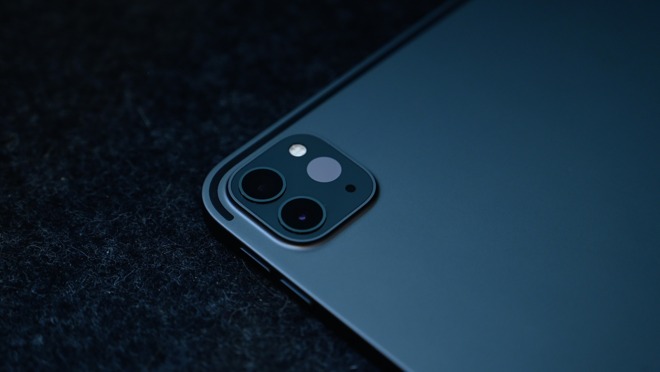
iPad Pro camera module
But the hardware is never the whole story. The software that powers them can make or break the experience. In recent years, iPadOS has become powerful with support for better multitasking, cursors, external storage, and much more. But it is still iPadOS. There is software and tasks that you can't do on a tablet.
As you decide between the two, take good consideration into what you plan to use your device for. Ask yourself if there are any tasks that you can't complete on an iPad, or if there are tasks you can't complete on the Mac. If what you do is doable on both, then it seems the iPad Pro may be the more well-rounded choice.
New 2020 11" iPad Pro deals

12.9-inch iPad Pro (right) and MacBook Air (left)
Features and differentiators
The 2020 MacBook Air has the same design as the 2018 model. It retains the two Thunderbolt 3 ports on the left side of the unit, and a headphone jack on the right. It has a 13.3-inch True Tone Retina display and a 720p FaceTime camera. It has a large glass trackpad and the updated Magic Keyboard.
11 and 12.9-inch iPad Pros
Apple's iPad Pro has a single USB-C port, a gorgeous Liquid Retina display that comes in 11-inch and 12.9-inch sizes, a 7MP TrueDepth camera system, a 12MP wide-angle camera, a 10MP ultra-wide camera, a LiDAR scanner, and an incredible A12Z Bionic processor. See more of these in the full review.
The iPad is running the latest version of iPadOS, Apple's forked version of iOS designed for tablets which has truly transformed over the past few years. With the last few major updates, we got the ability to multitask, have picture-in-picture, run split-screen apps, use an external monitor, a real cursor, save to external storage, and more.
The MacBook Air has benefitted from added features in macOS too. As a more mature OS, there is less flair coming with each update. MacBook Air has been able to do almost everything that the iPad can do for many years.
Performance
The 2020 iPad Pro has the new A12Z Bionic processor. We pit that, against the 10th-generation Intel Core i3 processor in the base 2020 MacBook Air.
Geekbench 5.1 scores for iPad Pro and MacBook Air
When we run the latest Geekbench 5.1 benchmark on the pair, it is clear the iPad Pro is powerful. iPad Pro garnered a 1117 and a 4653 in the single-core and multi-core tests respectively. That compares to a 1074 and 2412 the i3 MacBook Air earned.
Even when you shell out the $250 additional to get the quad-core i7 processor, the iPad Pro still wins. The i7 MacBook Air improved, but only to a 1294 single-core and a 3514 multi-core.

Video export test results
For a real-world test, we exported a 4K six-minute movie from iMovie on each device. The i3 MacBook Air took six minutes and two seconds, the i7 MacBook Air took five and a half minutes, and the iPad Pro only took three and a half minutes.
When it comes to processor-heavy or graphics-heavy tasks such as video editing, photo editing, iPad Pro is the better device to own, if you can handle doing so on iPadOS.
Closer than you'd think
If we make our best effort to bring these two in line -- in terms of specs and performance, things get very close.
2020 MacBook Air
We'd have to outfit the 12.9-inch iPad Pro with the Magic Keyboard (let's keep things first-party instead of looking at cheaper third-party options). That brings your total to roughly $1,350 for a similar-sized screen with a trackpad, keyboard, and two USB-C ports.
On the MacBook Air side, we need to increase its performance to get closer to the iPad Pro powerhouse. That means opting for the quad-core i7 processor which runs $250 on top of the $999 entry-level i3.
That puts two machines about $100 of one another.
Which to choose...
Performance alone shows that iPad Pro is faster and more graphically capable both in terms of benchmarks and real-world video export tests. It has a touch screen, can be outfitted with the same Magic Keyboard found on the MacBook Air, can have a trackpad, works with the Apple Pencil, and can transform from a laptop-like machine to a pure tablet in an instant.MacBook Air is stuck in its clamshell form factor, is slower than the iPad Pro even when you pay hundreds to upgrade the processor inside. There is no touch screen, no Apple Pencil support -- although though there are third-party sketchpads that can be used, no rear-shooting cameras at all, and the webcam isn't nearly as good as the 7MP TrueDepth camera system of the iPad Pro.

iPad Pro camera module
But the hardware is never the whole story. The software that powers them can make or break the experience. In recent years, iPadOS has become powerful with support for better multitasking, cursors, external storage, and much more. But it is still iPadOS. There is software and tasks that you can't do on a tablet.
As you decide between the two, take good consideration into what you plan to use your device for. Ask yourself if there are any tasks that you can't complete on an iPad, or if there are tasks you can't complete on the Mac. If what you do is doable on both, then it seems the iPad Pro may be the more well-rounded choice.
Deals on 2020 iPad Pros and MacBook Airs
Apple's new 2020 hardware is currently on sale at top resellers. For the lowest prices and best deals, check out our 2020 11-inch iPad Pro Price Guide, 2020 12.9-inch iPad Pro Price Guide and 2020 MacBook Air Price Guide.New 2020 11" iPad Pro deals
- 2020 11" iPad Pro (256GB, Wi-Fi) Space Gray: $849 ($50 off) [Also on sale at Amazon]
- 2020 11" iPad Pro (512GB, Wi-Fi) Space Gray: $1,049 ($50 off)
- 2020 11" iPad Pro (1TB, Wi-Fi) Space Gray: $1,249.99 ($50 off)
Find even more deals in our 2020 11" iPad Pro Price Guide...


Comments
A lot of these are very... specific and varied. Take editing a photo. Are we talking about adding a filter and adjusting a few sliders or are we talking more painstaking HDR composites or merging two photos to ensure everyone is smiling? Regardless, I prefer to do my photo editing on iPad rather than my Mac.
For video editing, it depends on the video editing. If you use a lot of plugins, motion templates, effects, etc then you are going to need to use the Mac. For editing without any of that, the iPad is absolutely fantastic. A lot of people just edit videos for fun and aren't using it in a professional capacity. As someone who edits videos for a living, I enjoy editing them on my iPad Pro and then I export them from LumaFusion and move them to Final Cut to finish them off.
Editing documents is going to largely be the same and spreadsheets used to be more laborious on a tablet until we got better mouse and keyboard support. Now those are largely the same too.
Oh, and we compare those because it is important to know how powerful a machine is. It only comes down to software because performance is (at the high end) comperable between the two. If performance was hugely one-sided, say the iPad had 1/4 the score of the Mac, why bother doing work on it if everything is slow?
It also makes you wonder why Windows on ARM is such failure.
Everything mobile really needs to transition to ARM... sorry Intel.
(by mobile, I mean everything with a battery)
Now, I'm not saying I'm about to "give up"... I expected a bit of a learning curve. But I did NOT expect to be told that SAFARI cannot handle FULL SCREEN VIDEOS! (to be fair, this doesn't hold true for ALL videos... I'm still trying to figure out WHY "some" just will not go full screen... ESPECIALLY on the AppleInsider site!! In an article ON the iPad Pro!
iPadOS is the main culprit right now, even though an Apple branded dock with many ports can’t hurt professional users.
Some glaring shortcomings when looking at iPad from the perspective of anyone wanting to use it beyond a consumer tablet:
- iPad Pro doesn’t attach to an external monitor like a MacBook does (native resolution, a true secondary display). That isn’t acceptable since the tablet itself is very small for day to day laptop like use.
- iPadOS is terrible for professional file management. Sharing, copying files just sucks with the files app because it’s the kiddie version of macOS Finder. Actually, any batch operations are pretty much impossible right now.
- iPadOS only recently got mouse/keyboard support and its a game changer, however with one USB-C port and the lack of professional grade apps like FCPX or Logic Pro, it can’t be relied on for professional use.
- iPadOS is a walled garden; it can’t work with ProRes, or can’t run Terminal for custom pipelines. It doesn’t run Xcode, so developers won’t really use it.
- Multi-user support is STILL not available.
- Working with multiple windows has become better but is an afterthought, because from a tablet perspective that makes perfect sense, jr not for advanced users who find it very limiting.
- There’s no desktop to arrange files; only a grid of apps and that concept is losing its use because it’s faster to slide-down and search for the app name, as opposed to finding your app in grid-labyrinth.
(ps: I just "stretched" the entire window out, to get it this large... but clearly, the text at top & bottom shows it is NOT full screen, and the lower right hand corner includes the "browser doesn't support" statement)
I think that youtube will prevent displaying videos fullscreen from inside apps for ad sales reasons. Ie, the app interferes with youtube ad display code and data scraping functionality, so they limit certain video features, and that's what you are running into here. It's a political reason like 4K youtube doesn't play on Macs because Apple won't support VP8, and youtube won't support HEVC 4k.
The new iPad is a great machine... I just don’t know who it was intended for. LiDAR and AR are great features, but not for 98% of users.
But I do disagree with the notion that iPadOS is somehow “crippled” because it doesn’t support all of the desktop-centric features and functionality of a desktop operating system. You could make the same exact claim about macOS being “crippled” because it doesn’t support all of the tablet-centric features of a tablet operating system. The reality is that iPadOS and macOS may be based on the same core OS code (and someday support similar processor architectures) but they each approached their respective user experiences from exact opposite ends of the spectrum.
Apple has always been very clear and purposeful about how macOS works on the products that run it. Apple’s macOS is very coherent and familiar to users of desktop computers with tethered keyboards and pointing devices. Resisting the temptation to add touch screens to macOS powered devices has allowed those devices to maintain the paradigm that they established over decades of use. No surprises, and where there are warts and geekiness, everyone knows about them and it’s no big deal. Plus, the geeks are happy to feel needed and socially elevated by being able to deftly disambiguate cruft, primitivity, and arcane navigation tricks that mere mortals are appalled by. What’s not to love?
Apple started off on the right track to deliver a premier tablet user experience for regular people with iPadOS/iOS with Steve sitting on a sofa with an iPad in his hands. Shortly thereafter, seeing a 94 year old and 3 year old equally comfortable with using an iPad with no or minimal training seemed to me to confirm that Apple nailed the user experience and had delivered a coherent product with purposeful intentions. The iPad was the perfect consumption device and sofa companion for regular people. But then things got weird. Was it the high price, premium materials, or the keyboard macro and Cmd+Option+right click loving geeks that insisted that the iPad had to be “more” than the perfect tablet?
All of a sudden you have some folks, like Tim Cook, saying that maybe the iPad was “all the computer you really needed.“ For people raised without personal computers or those who just need to FaceTime with friends, play some games, jot down some notes, watch a video, listen to music, read a book, or check their social security payments online, this was probably a true statement and it was great. But Apple couldn’t stop itself with the iPad being the ultimate sofa companion and consumption device. They started adding features that made NASA jealous and performance that stomped all over pedestrian PCs. Oh, and the price kept rising. So all of a sudden Apple kind of forgets all about the (huge and popular) niche the iPad serves so well and tries to force fit the iPad into new roles that justify its price. Maybe they looked at Microsoft with its Surface and felt a twinge of jealousy. After all, Microsoft got away with not even trying to bridge the PC-Tablet chasm and simply mushed both paradigms together into a play dough like blob that runs on a floppy keyboard scrunched down Windows notebook high priced thingamagig. Want touch, it got touch. Want keyboard+mouse, it got keyboard_mouse. Want BSOD? You got it.
Bottom line is that Apple has lost its way with the iPad. Differentiating the iPad products into regular and Pro versions is an admission of this loss of purposeful design. Can’t hit the target? Make the target twice as large. The iPad Pro is stuck in a tweener state of compromise that invites attacks from both sides. It has kitchen sink features that serve no useful purpose for those looking for a sofa companion and it comes across as a poor implementation of a desktop computer for those seeking a productivity workhorse. This is unfortunate because the iPad is truly a perfect computer for a lot of people who would not otherwise feel comfortable having a computer.
As strange as it sounds I think Apple has a way to regain control over the iPad if it further separates the consumer, sofa companion, version of the iPad from other products that are based on the iPad concept but are no longer sold as iPads, “pro” or not. Something akin to what would be a “MacPad.” A new product that evolves independently from iPad products and offers up all of the core productivity features and new fangled sensors for professionals in a touch enabled, compact form factor may be attractive for those who feel the current “Pro” iPads are too compromised. Leave the current iPad alone.
So, like with pointer support, eventually iPads will support external, extended displays, and will have an overlapping window UI. Not so sure about app side loading, but probably not. A user will be able to use it at a desk like a laptop or desktop, use it like a laptop, and use it like a tablet. A folding tablet that does all this will be interesting.
The touch interface I am very curious to see is what the touch pad on the magic folio is going to be like. From the video I am thinking its an imageless iPad screen and the touch and feel of it will be as if you are touching the screen. I wouldn’t be surprised if you could tap a particular segment of the touchpad and it opens the app that is located there.
I disagree, I do not think they have lost their way. When iPad started out, it was no where near the power that was needed to make a ‘Pro’ device. Not to mention that it did not have the programs... opps I mean apps (I know for me, my terminology use changed with iOS and the App Store) to compete with what was already out there. Flash forward to a few years ago and we now have enough power to move beyond a simple consumption device. One that can be used for computationally demanding tasks that could be labeled as ‘Pro’. It also now has powerful applications from prominent Software companies that only finally came on board because they were missing out on a growing market and shifting demands. Had Apple tried to over-promise and under-deliver it would have failed like the netbook and the surface. But it didn’t and it is here, improving and expanding beyond its initial purpose.
Apple recognizes that there are two uses for it’s iPad. Firstly as a consumption device, something that you prefer. And now, secondly, as a ‘Pro’ device. One that rethinks how you can input and output work with it. I don’t see a reason to leave the name iPad for a consumption device as it is the differentiator between MacOS and iOS. Just as Macs have a prosumer device called a MacBook Pro or and iMac Pro and still sell MacBooks, MacBook Airs, and iMacs. They are also selling iPads, iPad Airs, and iPad Pros.